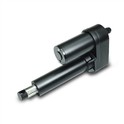Hey there! As a supplier of gas struts for tool boxes, I've gotten tons of questions about how these nifty little gadgets work. So, I thought I'd sit down and break it all down for you in this blog post.
First off, let's talk about what gas struts are. In simple terms, gas struts are like little shock absorbers that use compressed gas to provide a smooth and controlled motion. They're made up of a cylinder, a piston rod, and a seal, and they're filled with nitrogen gas under pressure. This gas is what gives the strut its lifting and damping properties.
So, how do they work in a tool box? Well, when you open your tool box, the gas strut starts to extend. The compressed gas inside the cylinder pushes against the piston rod, which in turn moves the lid of the tool box up. The strut is designed to provide a certain amount of force, which is determined by the size and pressure of the gas inside. This force is what helps to lift the heavy lid of the tool box and keep it open.
But it's not just about lifting the lid. Gas struts also provide damping, which means they control the speed at which the lid opens and closes. This is important because you don't want the lid to slam open or shut, which could damage the tool box or the tools inside. The damping effect is created by the way the gas flows through small channels in the piston. As the piston moves, the gas has to pass through these channels, which slows down the movement and provides a smooth, controlled motion.
Now, let's talk about the different types of gas struts for tool boxes. There are two main types: compression struts and tension struts. Compression struts are the most common type and are used to lift the lid of the tool box. They work by pushing the lid up when the strut is compressed. Tension struts, on the other hand, are used to hold the lid open. They work by pulling the lid up when the strut is extended.


When choosing a gas strut for your tool box, there are a few things you need to consider. First, you need to know the weight of the lid. This will determine the size and strength of the strut you need. You also need to consider the length of the strut and the mounting points. The length of the strut will determine how far the lid can open, and the mounting points will determine how the strut is attached to the tool box.
Another important factor to consider is the quality of the gas strut. You want to choose a strut that is made from high-quality materials and is designed to last. A good quality strut will have a durable seal that prevents the gas from leaking out, and it will be able to withstand the constant opening and closing of the tool box.
As a supplier of gas struts for tool boxes, I can offer you a wide range of options to choose from. Whether you need a compression strut or a tension strut, I can help you find the right one for your tool box. And if you have any questions or need help with installation, I'm here to assist you.
Now, let's talk about some other applications of gas struts. Gas struts are not just used in tool boxes. They're also used in a variety of other products, such as Gas Spring for Wall Bed, Gas Lift for Furniture, and Gas Spring for Kitchen Cabinet. In these applications, gas struts provide the same lifting and damping properties as they do in tool boxes, making them a popular choice for many different industries.
If you're in the market for gas struts for your tool box or any other application, I encourage you to get in touch with me. I can provide you with detailed information about our products, including specifications, pricing, and availability. I can also offer you samples so you can test the struts before you make a purchase.
In conclusion, gas struts for tool boxes are a simple yet effective solution for lifting and controlling the motion of the lid. They work by using compressed gas to provide a smooth and controlled motion, and they come in a variety of types and sizes to suit different needs. Whether you're a DIY enthusiast or a professional tool box manufacturer, gas struts can make your life easier and your tool box more functional. So, if you have any questions or need help choosing the right gas strut for your tool box, don't hesitate to contact me. I'm here to help you find the perfect solution for your needs.
References
- "Gas Struts: How They Work and Where They're Used." Engineering.com, https://www.engineering.com/story/gas-struts-how-they-work-and-where-theyre-used.
- "Gas Spring Basics." Suspa, https://www.suspa.com/en/gas-spring-basics/.






